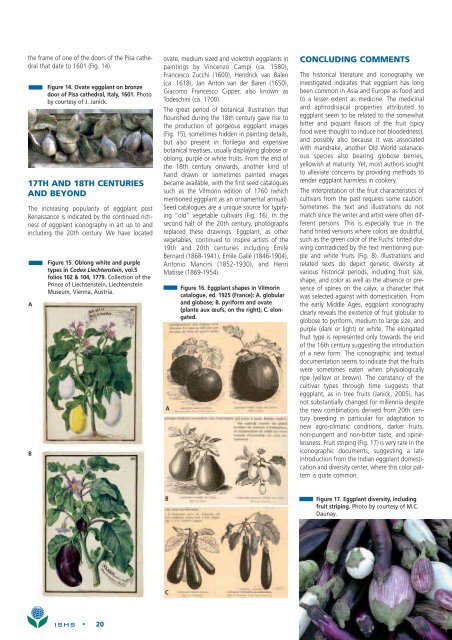Chronica - Acta Horticulturae
Chronica - Acta Horticulturae
Chronica - Acta Horticulturae
Create successful ePaper yourself
Turn your PDF publications into a flip-book with our unique Google optimized e-Paper software.
the frame of one of the doors of the Pisa cathedral<br />
that date to 1601 (Fig. 14).<br />
Figure 14. Ovate eggplant on bronze<br />
door of Pisa cathedral, Italy, 1601. Photo<br />
by courtesy of J. Janick.<br />
17TH AND 18TH CENTURIES<br />
AND BEYOND<br />
The increasing popularity of eggplant post<br />
Renaissance is indicated by the continued richness<br />
of eggplant iconography in art up to and<br />
including the 20th century. We have located<br />
A<br />
B<br />
Figure 15. Oblong white and purple<br />
types in Codex Liechtenstein, vol.5<br />
folios 102 & 104, 1779. Collection of the<br />
Prince of Liechtenstein, Liechtenstein<br />
Museum, Vienna, Austria.<br />
ovate, medium sized and violettish eggplants in<br />
paintings by Vincenzo Campi (ca. 1580),<br />
Francesco Zucchi (1600), Hendrick van Balen<br />
(ca. 1618), Jan Anton van der Baren (1650),<br />
Giacomo Francesco Cipper, also known as<br />
Todeschini (ca. 1700).<br />
The great period of botanical illustration that<br />
flourished during the 18th century gave rise to<br />
the production of gorgeous eggplant images<br />
(Fig. 15), sometimes hidden in painting details,<br />
but also present in florilegia and expensive<br />
botanical treatises, usually displaying globose or<br />
oblong, purple or white fruits. From the end of<br />
the 18th century onwards, another kind of<br />
hand drawn or sometimes painted images<br />
became available, with the first seed catalogues<br />
such as the Vilmorin edition of 1760 (which<br />
mentioned eggplant as an ornamental annual).<br />
Seed catalogues are a unique source for typifying<br />
“old” vegetable cultivars (Fig. 16). In the<br />
second half of the 20th century, photographs<br />
replaced these drawings. Eggplant, as other<br />
vegetables, continued to inspire artists of the<br />
19th and 20th centuries including Emile<br />
Bernard (1868-1941), Emile Gallé (1846-1904),<br />
Antonio Mancini (1852-1930), and Henri<br />
Matisse (1869-1954).<br />
A<br />
Figure 16. Eggplant shapes in Vilmorin<br />
catalogue, ed. 1925 (France): A. globular<br />
and globose; B. pyriform and ovate<br />
(plante aux œufs, on the right); C. elongated.<br />
CONCLUDING COMMENTS<br />
The historical literature and iconography we<br />
investigated indicates that eggplant has long<br />
been common in Asia and Europe as food and<br />
to a lesser extent as medicine. The medicinal<br />
and aphrodisiacal properties attributed to<br />
eggplant seem to be related to the somewhat<br />
bitter and piquant flavors of the fruit (spicy<br />
food were thought to induce hot bloodedness),<br />
and possibly also because it was associated<br />
with mandrake, another Old World solanaceous<br />
species also bearing globose berries,<br />
yellowish at maturity. Yet, most authors sought<br />
to alleviate concerns by providing methods to<br />
render eggplant harmless in cookery.<br />
The interpretation of the fruit characteristics of<br />
cultivars from the past requires some caution.<br />
Sometimes the text and illustrations do not<br />
match since the writer and artist were often different<br />
persons. This is especially true in the<br />
hand tinted versions where colors are doubtful,<br />
such as the green color of the Fuchs’ tinted drawing<br />
contradicted by the text mentioning purple<br />
and white fruits (Fig. 8). Illustrations and<br />
related texts do depict genetic diversity at<br />
various historical periods, including fruit size,<br />
shape, and color as well as the absence or presence<br />
of spines on the calyx, a character that<br />
was selected against with domestication. From<br />
the early Middle Ages, eggplant iconography<br />
clearly reveals the existence of fruit globular to<br />
globose to pyriform, medium to large size, and<br />
purple (dark or light) or white. The elongated<br />
fruit type is represented only towards the end<br />
of the 16th century suggesting the introduction<br />
of a new form. The iconographic and textual<br />
documentation seems to indicate that the fruits<br />
were sometimes eaten when physiologically<br />
ripe (yellow or brown). The constancy of the<br />
cultivar types through time suggests that<br />
eggplant, as in tree fruits (Janick, 2005), has<br />
not substantially changed for millennia despite<br />
the new combinations derived from 20th century<br />
breeding in particular for adaptation to<br />
new agro-climatic conditions, darker fruits,<br />
non-pungent and non-bitter taste, and spinelessness.<br />
Fruit striping (Fig. 17) is very rare in the<br />
iconographic documents, suggesting a late<br />
introduction from the Indian eggplant domestication<br />
and diversity center, where this color pattern<br />
is quite common.<br />
B<br />
Figure 17. Eggplant diversity, including<br />
fruit striping. Photo by courtesy of M.C.<br />
Daunay.<br />
C<br />
ISHS • 20
















